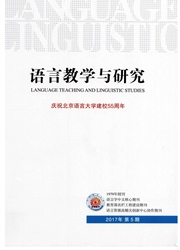

 中文摘要:
中文摘要:
已有研究显示,“来着”在不同语境下表现出“近过去时”、“回忆语气”及“委婉询问语气”等不同的用法。本文应用行、知、言三域的描述框架来分析这些用法之间的差异,考察“来着”在这三个认知域中的不同表意功能和句法表现;从主观性和交互主观性的角度分析这些用法之间的关联,知域用法是行域用法的主观性表达,当知域用法发展出交互主观性以后,就带有言域用法的意味。本研究显示,将认知域理论和主观性(化)理论结合有助于梳理某些虚词的共时变异和发展脉络。
 英文摘要:
英文摘要:
Previous studies show that sentence-final particle laizhe can be used as a tense marker indicating recent past, a mood particle indicating a mental process of recalling or a way of polite questioning. In this paper, the differences among those usages are analyzed based on a theory of three conceptual domains as put forward in Sweetser (1990) and Shen (2003). And the semantic and syntactic behaviors of laizhe within those three domains are compared. It is suggested that the association of the three distinctive usages is established from a perspective of subjectivity and inter-subjectivity. Laizhe in epistemic domain is a subjective expression of its usage in content domain. Once the epistemic usage carries on intersubjectivity, it can be viewed as a speech-act use. Combination of three conceptual domains theory and (inter-)subjectivity shows great advantage to explain the synchronic variation and diachronic evolvement of laizhe.
 同期刊论文项目
同期刊论文项目
 同项目期刊论文
同项目期刊论文
 期刊信息
期刊信息
